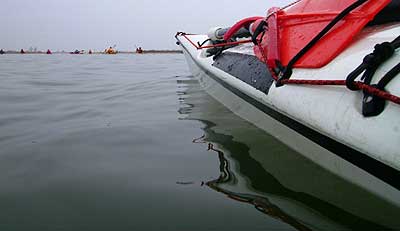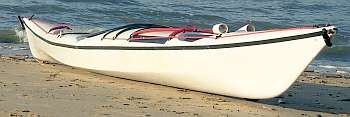- Details
Thinking about what kayak to take with me on the club outing to the IJsselmeer (Durgerdam - Marken vv.) on 1 march didn't take long because I didn't paddle the Silhouette in quiet weather yet.

- Details
Wednesday 25-02-09.
Due to ice, covering the inland waters, it's some time ago that I could make an evening workout. As tonight, when I arrived at the club, no members were present yet I took the Fjord and paddled her for an hour. I took the route just over the middle of the Alkmaardermeer. The wind blew with force 5Bft, arranging some nice waves for me.
At first I surfed with the wind pushing in my back from an angle, which is mostly a direction where weathercocking occurs. However with the variable skeg the Fjord could be perfectly trimmed to neutral. Only once I had to make a few corrective strokes to keep a straight course. At that time I did not realise I was surfing, causing the change of direction, because of the dark and invisible waves.
- Details
I attended a tour at the 25th of January, organized by Hans Heupink for the NKB (Dutch kayak Association). We entered the area around the Hinderplaat (near Stellendam) that has been closed since this year. But in wintertime entering is allowed after consulting the authorities and with the restriction that the event is organized by one of the Dutch kayak-associations..
The weather conditions were not encouraging with a SE-wind of (6 to) 7Bft and a temp 1-5¢ªC. But since I wanted to test the Silhouette in real conditions, I am motivated to withstand the cold. As I used today a dry-suit for the first time, I really felt comfortably under these circumstances. These dry-suits should have existed 20 years before; thinking of all those days while changing clothes in bad weather.
Underneath I describe my observations and thoughts of today:
- Details
Saturday a week ago I practised wet exercises with the Silhouette (Nigel Foster's) in the pool. I preferred, taking into account this time of the year, not to play around at sea but use a warmer environment . ![]()
Underneath I would like to share my experiences:
Rolling.
Although the kayak did not have the foam-blocks for knee-support (of which I am a fan), I could roll easily.
I rolled in 2 ways: rolling while bending forward on coming up and using the hipflick and, the other way, rolling up while bending to the afterdeck.
Both methods worked fine, but especially while coming up on the afterdeck I was happy with the seat-construction featuring a bulb as back-support instead of the usual backband. This way of back-support was very pleasant for my lower-back, as my backbone was not punctured by the cockpit-rim anymore.
Rolling with the paddle extended is not my strongest technique, but in the pool I managed to come up without any effort.
In general you can say that the Silhouette can be rolled normally. I only know of a few other kayaks that are easier to roll.
- Details
Arnold sent me this beautifull picture showing him paddling in surf at the beach near Parnassia in 2006.

It seems that in these steep waves the bow does not bury itself too much. Which fits with my experiences before.
Thx Arnold.
- Details
When Hans phoned me if I was available for a tour, this turned out to be a win-win-situation as he was looking for an alternative for his deleted weekend-camp-kayak-tour and I was looking for an one-day opportunity to continue testing the Silhouette. I would like to mention that the pictures below were made by Hans Heupink: thx again Hans.
We thought that the weather&sea could be interesting as the wind had been blowing hard the night before.
We started at Springersdiep in Zeeland and we had a nice paddling day. Hans paddling his AnasAcuta being of the same hard-chine kayak-family as the Silhouette.
We expected a sea being rough, but at the moment we made our first paddlestrokes, the wind started "dying" till approx. 4-5Bft. ![]()

- Details
A website is sometimes a nice communication medium. This time Arnold contacted me last week and offered me to try his Silhouette before he was going to sell it.
The Silhouette looks like she had an active paddling life yet, but seems to be in very good condition. She was built by John Van Leeuwen of Watermark, a company existing till approximately 1999 in the Netherlands. Watermark produced the NigelFoster kayaks at the time. As I heard strange stories about the construction and watertightness of these Watermark-kayaks, this one seems an exception, being well built.

- Details
Last night I had to paddle away some frustrations and I took the Greenlander for my weekly visit at the kayakclub; a 20km paddle vv.
It was very quiet weather with a mirror-like water surface.
What I noticed first was that the speed of this kayak is much better than the AnasAcuta; also a hard-chine kayak. Arriving at the club 65minutes later means an average speed of 8,7-9,0 km/h, which is not too bad for a seakayak.
My way back was somewhat troublesome as the water was beginning to freeze, creating large icefields. Astonishing that after 1,5 hours the ice was thick enough to require piercing the paddleblade very deliberate into it. Of course the ice dropped the speed a bit.
- Details

Years before I wrote a study about the Argonaut and Aquanaut; I travelled over de WWW and collected as much opinions as I could. It was interesting to see a general positive opinion gradually started to grow around this kayak. I did this survey for a friend who wanted to know more about these kayaks.
Later I tested the Avocet, a famous kayak being the starting point for the designs of the Aquanaut. "Today" Valley combined Aquanaut an Argonaut in one family: Aquanaut in 2 extensions LV and HV.
- Details
To repair or not to repair

You noticed perhaps that I did not write very much during the last two months.
Yes, that's right but there was a reason. Being a bit impulsive, I bought this NDK Greenlander which was punctured during a surf session and declared total loss. A nice project to improve on repairing kayaks; that's what I thought.

